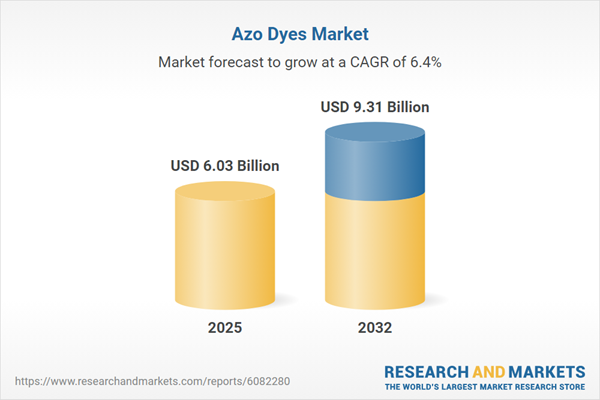Speak directly to the analyst to clarify any post sales queries you may have.
The Azo Dyes Market is undergoing critical evolution as sustainability imperatives, advancing dye technologies, and new regulatory standards demand fresh approaches across textiles, plastics, printing, and cosmetics. Senior executives face a shifting landscape that necessitates forward-looking insights for strategy and procurement.
Market Snapshot: Azo Dyes Market Size, CAGR, and Growth Outlook
The Azo Dyes Market achieved significant growth, moving from USD 5.67 billion in 2024 to USD 6.03 billion in 2025 and projecting a robust 6.39% CAGR through 2032, ultimately reaching USD 9.31 billion. This trajectory reflects enduring demand across major end-use sectors and swift adoption of advanced colorant technologies. Increased regulatory-compliant and environmentally responsible practices are strengthening long-term appeal. The sector benefits from prioritization of transparent supply chains and the integration of scalable, future-ready manufacturing approaches, contributing to its sustained progression and reliability in global markets.
Azo Dyes Market: Scope & Segmentation
This analysis delivers comprehensive segmentation and actionable detail to support strategic planning for senior decision-makers:
- Application Areas: Evaluation includes cosmetics, food and beverages, leather, paper (coated and uncoated), various plastics (such as PET, PP, PS, and PVC), printing inks for all major formats, and extensive breakdowns of textile use in materials including cotton, wool, nylon, and polyester.
- Dye Types: Report covers acid dyes, basic dyes, direct dyes, disperse dyes, mordant dyes, reactive dyes, and sulfur dyes, with further breakdown by key performance types and processes.
- Formulations: Includes granular (coarse and fine), liquid (both solvent-based and water-based), and powder (micro and standard) forms, underscoring buyer needs across different manufacturing modalities.
- Distribution Channels: Covers direct sales to OEMs and aftermarket, partnerships with global and local distributors, and analysis of B2B and B2C e-commerce channels as significant drivers in the supply chain.
- Regional Analysis: Spans Americas (with detailed country-level inclusion), Europe, Middle East & Africa, and Asia-Pacific (specifying leading economies), highlighting how geopolitical and resource dynamics are shaping regional opportunities and challenges.
- Technological Approaches: Details applications of continuous flow reactors, catalytic synthesis, advanced digital printing solutions, and the implementation of green chemistry and bio-based raw materials.
- Key Companies Profiled: Presents benchmarking and strategic assessment of BASF SE, DIC Corporation, Clariant AG, Huntsman Corporation, Solvay S.A., LANXESS AG, DyStar Group, and Sumitomo Chemical Company, Limited.
Key Takeaways for Senior Decision-Makers
- Sustainability priorities, especially the shift toward clean technology, are accelerating investments and leading to substantial reformulations in both established and emerging dye applications across industries.
- Strengthened oversight and enhanced compliance frameworks are required in response to regulatory actions aiming to lower exposure to hazardous substances, affecting all levels of the supply chain.
- Digital integration—including color-matching platforms and predictive analytics for inventory—enables organizations to boost operational responsiveness and optimize procurement and production cycles.
- Strategic collaborations among manufacturers, OEMs, and suppliers are becoming pivotal in speeding up innovation cycles and enabling differentiated product introductions.
- Growing volatility in trade environments is driving supply chain realignment, fostering risk diversification, and encouraging capital deployment toward more localized or resilient manufacturing strategies.
Tariff Impact: Strategic Shifts from Recent US Import Duties
New United States tariffs enacted in 2025 have recalibrated the cost structure for azo dyes. Market participants are adjusting by renegotiating supplier agreements, increasing local production of essential precursors, and seeking procurement from emerging regions that avoid these duties. These shifts elevate the importance of resilient supply chains and adaptive risk management strategies as trade environments continue to evolve.
Methodology & Data Sources
The research draws on a balanced methodology that incorporates interviews with senior leadership in research and development, procurement, and regulatory fields. Supplementary insights are extracted from proprietary survey data and supply chain audits, all validated by cross-referencing peer-reviewed literature, regulatory archives, and expert triangulation to ensure robust and actionable intelligence.
Why This Report Matters
- Clarifies the operational and product-development implications of new technology adoption, sustainability drivers, and regulatory compliance requirements.
- Identifies current shifts in competitive positioning and highlights regional opportunities for market entry and supply chain optimization.
- Supports data-driven R&D prioritization and procurement effectiveness, advancing secure positioning within the evolving azo dyes supply ecosystem.
Conclusion
This report delivers precise guidance for senior executives to strengthen compliance, drive innovation, and increase resilience. In a dynamic global landscape, these insights are essential for shaping adaptive and informed growth strategies.
Table of Contents
3. Executive Summary
4. Market Overview
7. Cumulative Impact of Artificial Intelligence 2025
Companies Mentioned
The companies profiled in this Azo Dyes market report include:- BASF SE
- DIC Corporation
- Clariant AG
- Huntsman Corporation
- Solvay S.A.
- LANXESS AG
- DyStar Group
- Sumitomo Chemical Company, Limited
Table Information
| Report Attribute | Details |
|---|---|
| No. of Pages | 190 |
| Published | November 2025 |
| Forecast Period | 2025 - 2032 |
| Estimated Market Value ( USD | $ 6.03 Billion |
| Forecasted Market Value ( USD | $ 9.31 Billion |
| Compound Annual Growth Rate | 6.3% |
| Regions Covered | Global |
| No. of Companies Mentioned | 9 |









